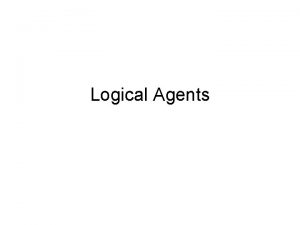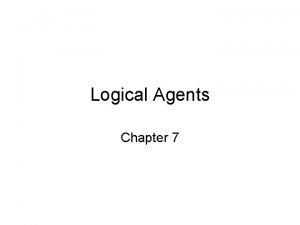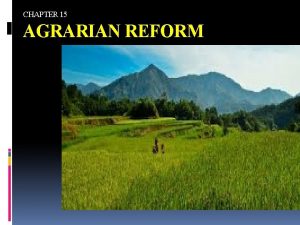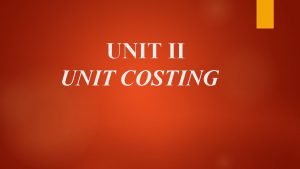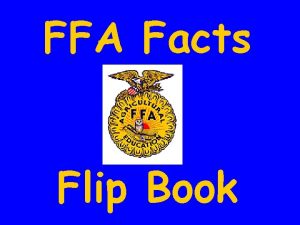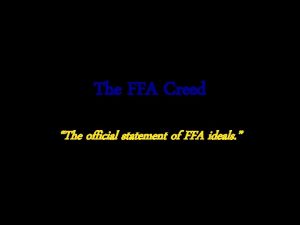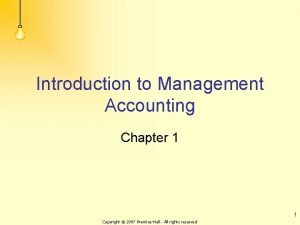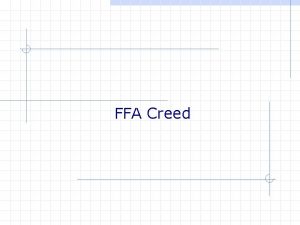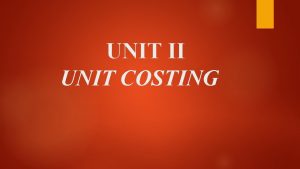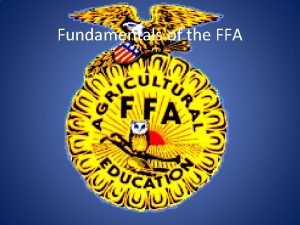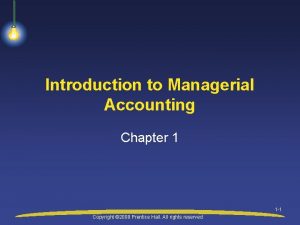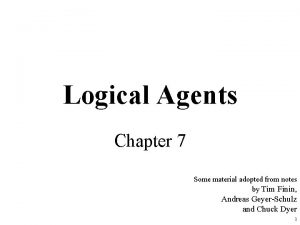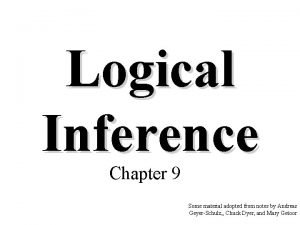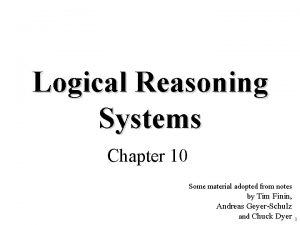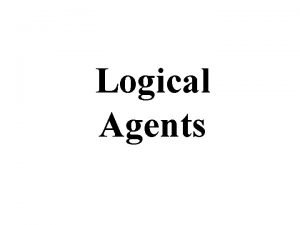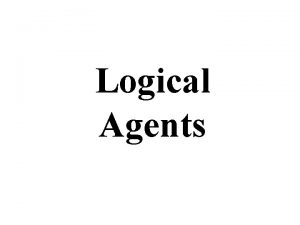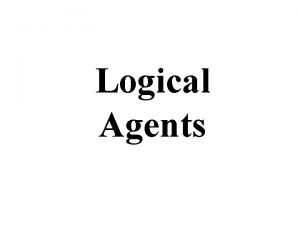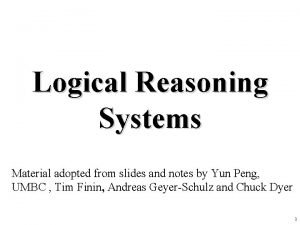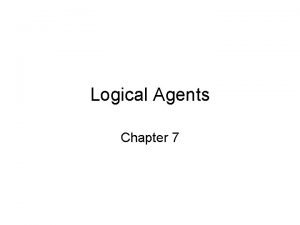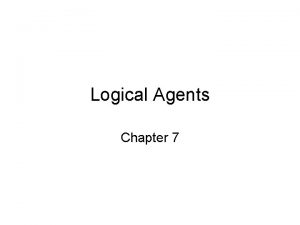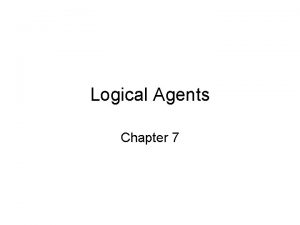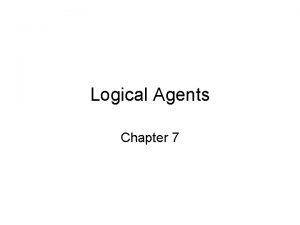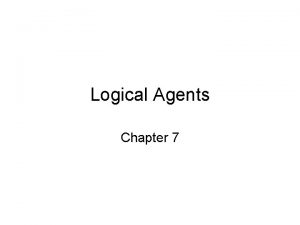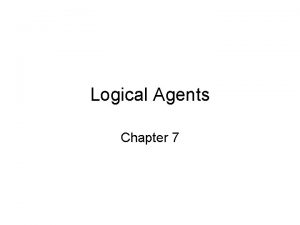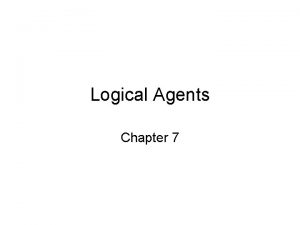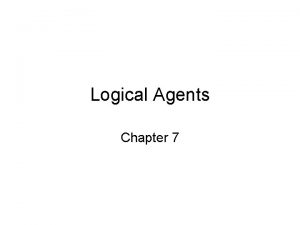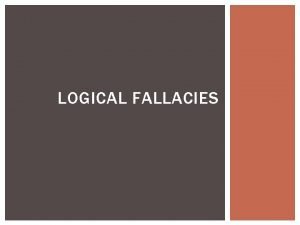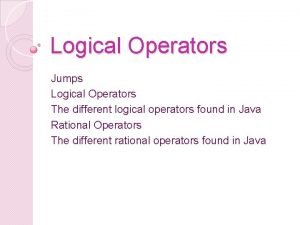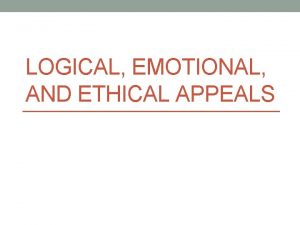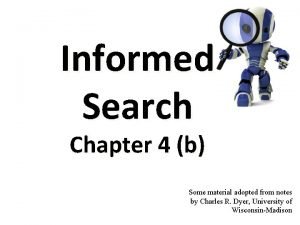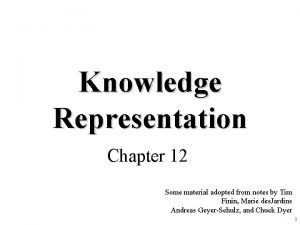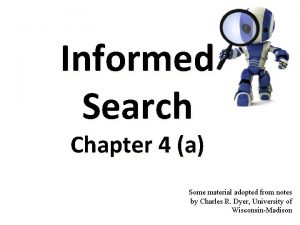Logical Agents Chapter 7 Some material adopted from




























- Slides: 28

Logical Agents Chapter 7 Some material adopted from notes by Tim Finin, Andreas Geyer-Schulz and Chuck Dyer 1

A Knowledge-Based Agent • A knowledge-based agent consists of a knowledge base (KB) and an inference engine (IE). • A knowledge-base is a set of representations of what one knows about the world (objects and classes of objects, the fact about objects, relationships among objects, etc. ) • Each individual representation is called a sentence. • The sentences are expressed in a knowledge representation language. • Examples of sentences – The moon is made of green cheese – If A is true then B is true – A is false – All humans are mortal – Confucius is a human 2

• The Inference engine derives new sentences from the input and KB • The inference mechanism depends on representation in KB • The agent operates as follows: 1. It receives percepts from environment 2. It computes what action it should perform (by IE and KB) 3. It performs the chosen action (some actions are simply inserting inferred new facts into KB). Input from environment Inference Engine Knowledge Base Output (actions) Learning (KB update) 3

KB can be viewed at different levels • Knowledge Level. – The most abstract level -- describe agent by saying what it knows. – Example: A taxi agent might know that the Golden Gate Bridge connects San Francisco with the Marin County. • Logical Level. – The level at which the knowledge is encoded into sentences. – Example: Links(Golden. Gate. Bridge, San. Francisco, Marin. County). • Implementation Level. – The physical representation of the sentences in the logical level. – Example: “(Links Golden. Gate. Bridge, San. Francisco, Marin. County)” 4

Representation, Reasoning, and Logic • The objective of knowledge representation is to express knowledge in a computer-tractable form, so that agents can perform well. • A knowledge representation language is defined by: – Its syntax which defines all possible sequences of symbols that constitute sentences of the language (grammar to form sentences) – Its semantics determines the facts in the world to which the sentences refer (meaning of sentences) • Each sentence makes a claim about the world. – Its proof theory (inference rules and proof procedures) 5

The Connection between Sentences and Facts Semantics maps sentences in logic to facts in the world. The property of one fact following from another is mirrored by the property of one sentence being entailed by (inferred from) another. 6

Logic as a KR language Multi-valued Logic Probabilistic Logic Fuzzy Logic Modal Temporal Non-monotonic Logic Higher Order First Order Propositional Logic 7

Propositional Logic: Syntax • Symbols: Logical constants: true (T), false (F) Propositional symbols: P, Q, S, . . . logical connectives: . . . conjunction (and) . . . disjunction (or) ~. . . negation (not) =>. . . implication (if) <=>. . . logical equivalence (if and only if) Wrapping parentheses: ( … ) • A proposition (denoted by a proposition symbol) is a declarative statement which can be either true or false but not both or neither. – The moon is made of green cheese (F) – UMBC is closer to Baltimore than to Washington, DC (T) – P = NP (truth unknown) 8

• Sentence 1. T or F itself is a sentence 2. Individual proposition symbols P, Q, . . . are sentences 3. If S is a sentence, so is (S) 4. If S 1 and S 2 are sentences, so are S 1 S 2, S 1 => S 2, S 1 <=> S 2, ~ S 1 5. Nothing else is a sentence • Order of precedence of logical connectors ~ , , , => , <=> • Minimum set of logical connectors (~ , ), or (~ , ) • Atomic sentences: T, F, P, Q, . . . • Literals: atomic sentences and their negations 9

Examples of PL sentences • P means "It is hot" • Q means "It is humid" • R means "It is raining" • P ^ Q => R "If it is hot and humid, then it is raining" • Q => P "If it is humid, then it is hot" • Q "It is humid. " 10

Propositional Logic (PL): Semantics • Need an interpretation of symbols for a given set of sentences – Proposition symbols do not have meaning by themselves – An interpretation connects proposition symbols to a statement about the world (which may be true or false in that world) – An interpretation in PL can be defined as an assignment of truth values to all proposition symbols involved – There are many interpretations for a given set of sentences (2^n if they involve n distinct proposition symbols) – Example: I_1: P: it is humid (T) Q: it is hot (T). P ^ Q is true I_2: P: moon is made of green cheese (F); Q: I am happy (T). P ^ Q is false 11

• Give a meaning to each logical connectives – A connective is a function (boolean), – It does not depend on any particular interpretations (universal to all PL sentences) – It can best be defined by a truth table • Truth value of each sentence can then be calculated Truth tables for logical connectives P T T F F Q T F ~ P F F T T PÙQ T F F F PÚQ T T T F P => Q T F T T P <=> Q T F F T 12

• Implication – Approximating causal relationships – Many logic theoreticians are not happy about the current definition for P = F • Equivalence laws in PL (both sides have the same truth table) – P => Q ≡ ~P v Q – P <=> Q ≡ (P => Q) ^ (Q => P) – Distribution law P ^ (Q v R) ≡ (P ^ Q) v (P ^ R) P v (Q ^ R) ≡ (P v Q) ^ (P v R) – De Morgan’s law ~(P v Q v R) ≡ ~P ^ ~Q ^ ~R ~(P ^ Q ^ R) ≡ ~P v ~Q v ~R 13

Some terms • A model is an interpretation of a set of sentences such that every sentence is True. A model is just a formal mathematical structure that "stands in" for the world. • A sentence is satisfiable if it is True under some interpretation(s) • A valid sentence or tautology is a sentence that is True under all possible interpretations, no matter what the world is actually like or what the semantics is, e. g. , • An inconsistent sentence or contradiction is a sentence that is False under all interpretations. The world is never like what it describes, e. g. , • P entails Q (Q is a logical consequence of P, Q logically follows P), written P |= Q, means that whenever P is True, so is Q. In other words, all models of P are also models of Q. 14

Models of Complex Sentences (Venn diagrams) 15

Entailment and derivation • Entailment: KB |= Q – Q is entailed by KB (a set of premises or assumptions) if and only if there is no logically possible world in which Q is false while all the premises in KB are true. – Or, stated positively, Q is entailed by KB if and only if the conclusion is true in every logically possible world in which all the premises in KB are true. • Derivation: KB |- Q – We can derive Q from KB if there is a proof consisting of a sequence of valid inference steps starting from the premises in KB and resulting in Q 16

Inference Rule • Logical Inference is used to create new sentences X that logically follow from a given set of sentences S (in KB and from input), i. e. , S |= X • This kind of inference is also known as deduction • Use truth table: Whether S |= X holds can be determined by whether S => X is a tautology – S |= X holds iff every interpretation I that makes S true also makes X true S => X is a tautology iff every interpretation I that makes S true also makes X true – Example: P, P => Q |= Q because (P, P => Q) => Q is true under any interpretation – Huge truth tables for inference involving large number of sentences 17

• Use inference rules: generate new sentences X from a one or more existing sentences S. S is called the premise and X the conclusion of the rule. • Proof procedure: a set of inference rules and a procedure of how to use these rules • If X can be generated from S by proof procedure i, we say X is derived from S by i, denoted S |i X, or S | X. • Soundness. An inference procedure is sound if every sentence X it produces from a set of sentences S logically follows from S. (No contradiction is created). For all S and X, if S | X then S |= X • Completeness. A inference procedure is complete, if it is able to produce every sentence that logically follows from any give S. For all S and X, if S |= X then S | X 18

Sound Inference Rules (deductive rules) • Here are some examples of sound rules of inference. • Each can be shown to be sound using a truth table -- a rule is sound if it’s conclusion is true whenever the premise is true. RULE PREMISES CONCLUSION Modus Ponens Modus Tollens And Introduction And Elimination Or Introduction Double Negation Chaining A, A => B ~B, A => B A, B A^B A ~~A A => B, B => C B ~A A^B A Av. B A A => C 19

• Resolution rule Unit Resolution A v B, ~A A v B, ~B v C B Av. C – Operates on two disjunctions of literals – The pair of two opposite literals cancel each other, all other literals from the two disjunctions are combined to form a new disjunction as the inferred sentence – Resolution rule can replace all other inference rules Modus Ponens A, ~A v B B Modus Tollens ~B, ~A v B ~A Chaining ~A v B, ~B v C ~A v C 20

Soundness of the Resolution Inference Rule 21

Proving things • A proof is a sequence of sentences, where each sentence is either a premise (also called an axiom) or a sentence derived from earlier sentences in the proof by one of the rules of inference. • The last sentence is theorem that we want to prove (also called goal or query). • Complete proof procedure for PL has time complexity exponential to the number of premises • Example for the "weather problem" given before. 1 Q Premise “It is humid” 2 Q=>P Premise “if it is humid, it is hot” 3 P Modus Ponens(1, 2) “It is hot” 4 (P^Q)=>R Premise “If it’s hot & humid, it’s raining” 5 P^Q And Introduction(1, 3) “It is hot and humid” 6 R Modus Ponens(4, 5) “It is raining” 22

• Proof by resolution Q ~Q v P ~P v ~Q v R premises P ~Q v R R theorem • Theorem proving as search – Start node: the set of given premises/axioms (KB + Input) – Operator: inference rule (add a new sentence into parent node) – Goal: a state that contains theorem asked to prove – Solution: a path from start node to a goal 23

Normal forms of PL sentences • Disjunctive normal form (DNF) – Any sentence can be written as a disjunction of conjunctions of literals. – Examples: P ^ Q ^ ~R; A^B v C^D v P^Q^R; P – Widely used in logical circuit design (simplification) • Conjunctive normal form (CNF) – Any sentence can be written as a conjunction of disjunctions of literals. – Examples: P v Q v ~R; (A v B) ^ (C v D) ^ (P v Q v R); P • Normal forms can be obtained by applying equivalence laws [(A v B) => (C v D)] => P ~[~(A v B) v (C v D)] v P [~~(A v B) ^ ~(C v D)] v P [(A v B)^(~C ^ ~D)] v P (A v B v P)^(~C^~D v P) (A v B v P)^(~C v P)^(~D v P) a CNF 24

Horn Sentences • A Horn sentences is a disjunction of literals with at most one of these literals being non-negated (positive). ~P 1 v ~P 2 v ~P 3. . . v ~Pn v Q; or alternatively P 1 ^ P 2 ^ P 3. . . ^ Pn => Q; (an implication or if-then rule) or Q <= P 1 ^ P 2 ^ P 3. . . ^ Pn (in prolog format) • Some properties of Horn sentences – P => (Q ^ R) (P => Q) ^ (P => R) – (P v Q) => R (P => R) ^ (Q => R) – P => (Q v R) cannot be represented as Horn sentences • We will expand Horn sentences to Horn clauses in first order predicate logic later and give it more discussion then • As we will see later, Horn clauses make automating logical inference easier. 25

PL is Too Weak a Representational Language • Consider the problem of representing the following information: – Every person is mortal. (S 1) – Confucius is a person. (S 2) – Confucius is mortal. (S 3) • S 3 is clearly a logical consequence of S 1 and S 2. But how can these sentences be represented using PL so that we can infer the third sentence from the first two? • We can use symbols P, Q, and R to denote three propositions, but this leads us to nowhere because knowledge important to infer R from P and Q (i. e. , relationship between being a human and mortality, and the membership relation between Confucius and human class) is not expressed in a way that can be used by inference rules 26

Weakness of PL • Alternatively, we can use symbols for parts of each sentence – P = "person”; M = "mortal”; C = "Confucius" – The above 3 sentences can be roughly represented as: S 2: C => P; S 1: P => M; S 3: C => M. – Then S 3 is entailed by S 1 and S 2 by the chaining rule. • Bad semantics – “Confucius” (and “person” and “mortal”) are not PL sentences (not a declarative statement) and cannot have a truth value. – What does P => M mean? • We need infinite distinct symbols X for individual persons, and infinite implications to connect these X with P (person) and M (mortal) because we need a unique symbol for each individual. Person_1 => P; person_1 => M; Person_2 => P; person_2 => M; . . . Person_n => P; person_n => M 27

Weakness of PL • Hard to identify "individuals. " E. g. , Mary, 3 – Individuals cannot be PL sentences themselves. • Difficult to directly and clearly talk about properties of individuals or relations between individuals (hard to connect individuals to class properties). – E. g. , property of being a human implies property of being mortal • Generalizations, patterns, regularities can't easily be represented. – All members of a class have this property – Some member of a class have this property • A better representation is needed to capture the relationship (and distinction) between objects and classes, including properties belonging to classes and individuals • First-Order Logic (abbreviated FOL or FOPC) is expressive enough to concisely represent this kind of situation by separating classes and individuals – Explicit representation of individuals and classes, x, Mary, 3, persons. – Adds relations, variables, and quantifiers, e. g. , • “Every person is mortal” Forall X: person(X) => mortal(X) • “There is a white alligator” There exists some X: Alligator(X) ^ white(X) 28
 Logical agents
Logical agents Wumpus world prolog
Wumpus world prolog Define logical equivalence
Define logical equivalence Logical equivalence in discrete mathematics
Logical equivalence in discrete mathematics Scrap account
Scrap account When was ffa creed adopted
When was ffa creed adopted Compras y vandalas meaning
Compras y vandalas meaning Unit costing meaning
Unit costing meaning Who wrote the ffa creed? when was it adopted?
Who wrote the ffa creed? when was it adopted? Color and label the circles with the official ffa colors
Color and label the circles with the official ffa colors Individual prescription order system
Individual prescription order system Who are responsible for curriculum development in pakistan
Who are responsible for curriculum development in pakistan I believe in less dependence on begging
I believe in less dependence on begging The institute of management accountants adopted the ______.
The institute of management accountants adopted the ______. What year was the ffa creed adopted
What year was the ffa creed adopted Meaning of unit costing
Meaning of unit costing Internal screw thread
Internal screw thread When was the ffa creed adopted and amended
When was the ffa creed adopted and amended Managerial accounting skills are ______.
Managerial accounting skills are ______. Sometimes you win some
Sometimes you win some They say sometimes you win some
They say sometimes you win some Sweets countable or uncountable noun
Sweets countable or uncountable noun Contact and non contact forces
Contact and non contact forces Some say the world will end in fire some say in ice
Some say the world will end in fire some say in ice Some say the world will end in fire some say in ice
Some say the world will end in fire some say in ice Some may trust in horses
Some may trust in horses Geometric symbols and their meanings
Geometric symbols and their meanings Rsq formula in standard costing
Rsq formula in standard costing Ethnocentrism examples
Ethnocentrism examples
